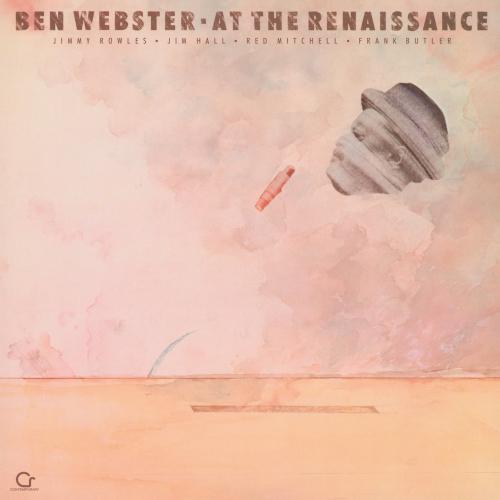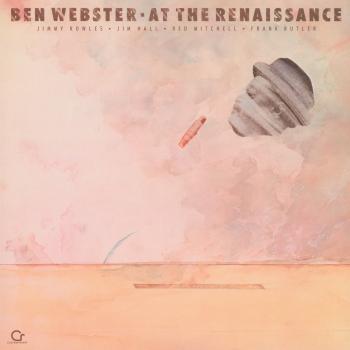
At The Renaissance (Live At The Renaissance / 1960 / Remastered 2024) Ben Webster, Jimmy Rowles, Jim Hall, Red Mitchell, Frank Butler
Album info
Album-Release:
1960
HRA-Release:
08.11.2024
Label: Craft Recordings
Genre: Jazz
Subgenre: Cool
Artist: Ben Webster, Jimmy Rowles, Jim Hall, Red Mitchell, Frank Butler
Album including Album cover
I`m sorry!
Dear HIGHRESAUDIO Visitor,
due to territorial constraints and also different releases dates in each country you currently can`t purchase this album. We are updating our release dates twice a week. So, please feel free to check from time-to-time, if the album is available for your country.
We suggest, that you bookmark the album and use our Short List function.
Thank you for your understanding and patience.
Yours sincerely, HIGHRESAUDIO
- 1 Gone With The Wind (Live At The Renaissance / 1960 / Remastered 2024) 09:30
- 2 Stardust (Live At The Renaissance / 1960 / Remastered 2024) 11:23
- 3 Caravan (Live At The Renaissance / 1960 / Remastered 2024) 10:16
- 4 Georgia On My Mind (Live At The Renaissance / 1960 / Remastered 2024) 06:49
- 5 Ole Miss Blues (Live At The Renaissance / 1960 / Remastered 2024) 07:14
- 6 Mop Mop (Live At The Renaissance / 1960 / Remastered 2024) 08:24
- 7 What Is This Thing Called Love (Live At The Renaissance / 1960 / Remastered 2024) 07:47
- 8 Renaissance Blues (Live At The Renaissance / 1960 / Remastered 2024) 06:15
Info for At The Renaissance (Live At The Renaissance / 1960 / Remastered 2024)
Recorded live at The Renaissance in Hollywood on Oct 14, 1960, this reissue of Ben Webster's At the Renaissance is a "consistently wonderful" album notes AllMusic, that finds the saxophonist "in superior and creative form." The New Yorker, for its part, has anointed Webster one of the "founding emperors of the jazz tenor saxophone." The superlative performance from the Duke Ellington Orchestra alum and his band — pianist Jimmy Rowles (Sarah Vaughan, Ella Fitzgerald), guitarist Jim Hall (Jimmy Giuffre, Sonny Rollins), bassist Red Mitchell (André Previn, Billie Holliday), and drummer Frank Butler (Duke Ellington, John Coltrane) — features something for everyone: from a feather-light, sentimental take on "Georgia on My Mind" to the swaggering insouciance of "Ole Miss Blues."
"This live set features tenor great Ben Webster playing with pianist Jimmy Rowles, guitarist Jim Hall, bassist Red Mitchell, and drummer Frank Butler in a club, and the music is consistently wonderful. Whether showing warmth and sentimentality on "Georgia on My Mind" and "Stardust" or growling and roaring on "Caravan" and "Ole Miss Blues," Webster (who was then somewhat taken for granted) is in superior and creative form. Recommended." (Scott Yanow, AMG)
Ben Webster, tenor saxophone
Jim Hall, guitar
Jimmy Rowles, piano
Red Mitchell, bass
Frank Butler, drums
Recorded at The Renaissance, Hollywood, October 14, 1960
Digitally remastered
Please Note: We offer this album in its native sampling rate of 48 kHz, 24-bit. The provided 192 kHz version was up-sampled and offers no audible value!
Ben Webster
The nickname ”The Brute and the Beautiful” was aptly given to tenor saxophonist Ben Webster. He became famous for his beautiful sound which gave his ballad playing a unique touch of tenderness, while his playing in faster tempos was virile and filled with growl, and when sober he was the kindest and gentlest man, witty and entertaining and the natural center of the gathering, while he was unpredictable and violent when he had consummated too much of alcohol. Despite this Dr. Jekyll-Mr. Hyde-personality he was a much loved musician and recorded a fairly amount of excellent records of which most still are in stock, due to the fact that he is the best selling tenor saxophonist in jazz.
Ben(jamin Francis) Webster was born in Kansas City, MO on March 27, 1909. In elementary school he studied violin and taught himself piano, inspired by the nearby living Pete Johnson who taught him to play the blues. In 1927 he played for silent movies in Kansas City, but left town a little later to play with a small territory band, but in the spring of 1928 he was again playing for silent movies, this time in Amarillo, Texas. Here he met Budd Johnson who taught him how to make a sound on a saxophone, and Webster got so interested that he borrowed an alto saxophone. In 1930 he left Amarillo with Gene Coy’s Happy Black Aces, and after a few months Coy baught him his first tenor saxophone, because ”I couldn’t express myself on alto. The tenor had a bigger sound.”
From then on, Webster’s carreer took some fast leaps forward. After Coy, he joined first Jap Allen’s band and then Blanche Calloway’s before he became a member of Bennie Moten’s important band and contributed some fine solos on the band’s famous marathon recording session in December 1932, such asMoten Swing. Shortly afterwards, Webster returned to Kansas City where he got hired by Andy Kirk, and in June 1934 he went to New York to play with Fletcher Henderson’s famous orchestra, actually switching job with Lester Young who in turn went to Kirk. The next few years were spent with Benny Carter (late 1934), who was the first to see Webster’s potential as a ballad interpreter (Dream Lullaby), Willie Bryant (1935-36), Cab Calloway (1936-37), before he rejoined Henderson in July 1937 for a short year after which he joined first Stuff Smith and later Roy Eldridge in New York. During these years, Webster also participated in some small group recording sessions, notably those led by Teddy Wilson and Billie Holidaye e.g. What a Little Moonlight Can Do.
In April 1939 he became a member of Teddy Wilson’s big band and was its most important soloist, but a dream came true when he was offered a permanent job in Duke Ellington’s orchestra. He therefore left Wilson in January 1940 and went to Boston to play his first job with Ellington. (Actually he had subbed for Barney Bigard on two short occasions, in 1935 and 1936).
Webster stayed with Ellington until early August 1943, and it was during these years he gained national and international fame with recordings like Cotton Tail - which became his signature tune -Jack the Bear, Harlem Air Shaft, and Sepia Panorama.
Webster started out as a Coleman Hawkins disciple, but under the influence of Ellington his style matured and became more personal. In quick tempos his solos contained great rhytmic momentum, a rasping timbre and an almost brutal aggressiveness, while his ballad playing was breathy and sensual, delivered with one of the most beautiful sounds ever captured on a tenor saxophone.
After leaving Ellington, Webster formed his own small groups or played with other small ensembles, e.g. John Kirkby in 1944 in New York. In late 1948 he rejoined Ellington for a short year, after which Webster returned to Kansas City to play with Bus Moten, Bob Wilson and Jay McShann. From 1952 he spent his time between Los Angeles and New York playing with his own groups, freelancing, or recording with a variety of soloists, among them singers like Billie Holiday, Ella Fitzgerald, Carmen McRae, Frank Sinatra, Joe Williams, and Jimmy Witherspoon with whom Webster toured reguarly around 1960.
Webster toured with Norman Granz’s Jazz at the Philharmonic in the fall of 1953 and 1954, and it was also Granz who was instrumental in giving Webster a recording contract that gave his career a new lift with excellent albums such as King of the Tenors (1953) and Ben Webster Meets Oscar Peterson (1959.
In early December 1957 Webster took part in the now legendary CBS TV broadcast The Sound of Jazz where he both performed with Count Basie and with Billie Holiday, and in the latter he was united with the other two swing era tenor saxophone greats, Coleman Hawkins and Lester Young, the only occasion they played together ever. Everyone played excellently on Fine and Mellow, Young very moving, Hawkins with self-confidence, and Webster intense and emotional.
Despite fine reviews of his albums, it was difficult for Webster to find steady work in New York during the early 1960’s, and when an offer to play for a month at Ronnie Scott’s Club in London turned up in late 1964 he accepted and sailed to England.
Webster never returned to the United States. In Europe he found plenty of work, and after the successful London gig, he flew to Scandinavia for weeklong residences in Stockholm, Copenhagen, and Oslo, settled in Amsterdam (1966-69) and then in Copenhagen. He toured frequently, mostly in Northern Europe, playing in clubs or at festivals with local bands or with expatriate or visiting American musicians, such as Benny Carter, Bill Coleman, Don Byas, Kenny Drew, Teddy Wilson, Red Mitchell, Charlie Shavers, Carmell Jones, Brew Moore, Dexter Gordon, Clark Terry, and Buck Clayton.
Even if his body declined during his last years, his playing never did. To the last day Webster played with passion and intensity, and his ballad playing became even more beautiful and tender, simplified almost to the laconic and delivered with weight on every note. He never launched into double-time while playing ballads, as was the custom with most tenor saxophonists at that time, but maintained the song’s feeling throughout while staying in the slow tempo. Webster was one of the unique jazz musicians whose presence came through on every recording.
Webster is regarded as one of the three foremost swing era tenor saxophonists – the two others being Coleman Hawkins and Lester Young. His ballad playing and sound inspired such later fellow saxophonists as Paul Gonsalves, Harold Ashby, Archie Shepp, Eddie ”Lockjaw” Davis, Frank Foster, Sonny Rollins, Flip Phillips, Georgie Auld, John Coltrane, Scott Hamilton, and Branford Marsalis. His rough playing with growl was emulated by Charlie Ventura and David Murray, and it also inspired R&B and rock saxophonists, who often combined the use of growl with altissimo notes. (Source: benwebsterfoundation.com)
This album contains no booklet.











